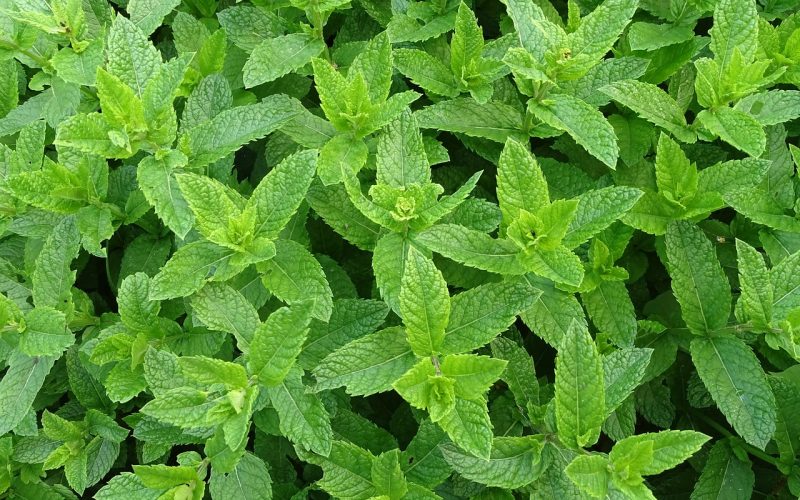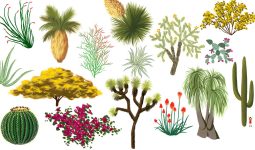Lamiaceae or Labiatae is the scientific and botanical name for the mint family of plants.
All the different types of mint have distinctive scents that help identify them.
Peppermint, spearmint, and chocolate mint are the most common types, but other types of mint may be grown in your garden.
It doesn’t matter what kind of plant you’re cultivating since they’re all invasive.
Due to their quick proliferation, mint plants are frequently grown in containers.
Different Types of Mint
1. Peppermint
Peppermint is one of the most popular different types of mint. Water mint and spearmint are combined to provide a flavorful but sweet scent.
Adding peppermint to desserts, drinks, and candies provides a refreshing yet strong flavor.
Additionally, it may be used in both sweet and savory meals. Runners, not seeds, are the primary means peppermint spreads over garden beds.
Due to its quick expansion, Peppermint has spread like wildfire over the United States and the rest of the world.
The leaves of these mints are dark green, yet they contain reddish veins.
2. Chocolate Mint
This is one of the different types of mint that may take over other plants surrounding it if you don’t keep an eye on it, as it has square stems.
A chocolate mint’s yellow-tinged leaves give out a strong scent and a pleasing visual appearance.
This plant thrives in full to partial sunlight, with good soil and a lot of water.
They may also be grown in containers. It’s a favorite ingredient in beverages and sweets since it’s so aromatic.
The chocolate mint plant not only forms a lovely garnish but also yields a chocolate mint tea that is refreshing and flavorful.
Pour boiling water over the herbs and let them soak for five minutes.
Extracting oil from the plant to make your essential oil is possible, and the plant grows quickly enough to keep you well-stocked.
3. Pineapple Mint
There are white edgings on the pineapple mint plant’s deep green leaves.
It’s a popular decorative plant because of this color, and it can thrive in zones five through nine with protection and zone four without protection.
It may reach two to three feet and thrive in full sunlight. This plant’s white or pink flowers appear in the middle of the summer when the soil is rich.
The mint plant’s sweet and lemony flavor has made it a popular choice for medical and herbal purposes.
You may use it as a beautiful garnish, in fruit salads and jellies, or even to flavor tea. Pineapple mint is also commonly used in fruit potpourri.
Arthritis and gastrointestinal problems benefit greatly from this supplement’s anti-inflammatory qualities. Acid reflux can also be reduced with this.
4. Spearmint
Spearmint, often known as common mint, is among the most common different types of mint. It’s used primarily in the kitchen.
Unlike peppermint, spearmint’s leaves are slender and green, with a milder scent.
Long, thin leaves cover spearmint bushes, which produce beautiful pink or white flowers on long spikes.
The leaves resemble a spear, giving rise to the common name “spearmint.” Spreading through invasive runners in all directions is how spearmint spreads; thus, containers are ideal.
Since it’s commonly used in lamb and potato recipes, it has been called lamb mint. Toothpaste, soaps, and other skincare products are also made using spearmint.
5. Corn Mint (American Wild Mint)
This species of mint, often known as wild mint, is native to the United States. Soil that holds water and a sunny location is essential for its growth.
Before you plant your mint, add some compost to the sandy soil. It will produce a square stem with flower tufts developing every few inches after you deadhead it to keep it from spreading.
Corn mint, a favorite treatment for the common cold, grows between 6 and 18 inches tall.
Chewing on the leaves might help relieve congestion and calm a coughing fit.
Making tea with fresh leaves and boiling water is an additional option.
Add this mint to a lotion base and make a vapor rub for your chest if you wish to boil the leaves to extract the oils.
6. Lavender Mint
People looking for a low-maintenance plant will appreciate the mixture of the red stem and dark green leaves on this mint.
This mint is drought-resistant, and mulch may be used to keep it from drying out.
Ensure it doesn’t take over your garden by planting it in full to partial sunlight.
In a large and shallow container, you may grow this mint and other different types of mint.
Lavender mint is one of the different mint types popular in medical and herbal applications because of its enticing scent.
Personal care products, including lip balms, potpourri, lotions, and shampoos, often have this scent.
It is delicious when served with fresh strawberries, soups, and pasta. Hot or cold, it may be used to improve the flavor of the meat.
7. Ginger Mint
The scent of this mint is a mix of spearmint and maize mint, and it has a subtle minty flavor that lingers.
You’ll get the best results if you plant it in heavy, clay-rich soil and full or partial sunlight.
To assist your mint plant in retaining moisture and avoid drying out, mulch the entire surrounding area.
Fresh fruit salads and drinks taste great with this subtle mint flavor. Teas and lemonades can benefit from the addition of this taste.
The finely chopped mint leaves can be spread with melted butter or margarine.
Ginger mint leaf marinades are also commonly used to marinate fish and other grilled meats.
8. Corsican Mint
The smallest member of the mint family is the Corsican type, a low-growing, creeping mint.
The leaves of the Corsican mint are tiny and oval-shaped, with vivid green leaves.
When the leaves are crushed, they give out a pungent smell. Since it won’t die if you step on it, Corsican mint is a popular choice for border and bedding plants.
When it’s fully developed, it may be rather invasive, so use caution. Tiny mauve flowers attract pollinators to the plant.
Putting Corsican mint near those plants will prevent many pests that attack broccoli, cabbage, and cauliflower.
Its antibacterial properties and flatulence-relieving effects make it useful in medicine.
9. Orange Mint
The orange mint plant will thrive in areas of your yard with clay-rich soil that is thick and moist.
It thrives in direct sunlight but can also tolerate partial shade and neglect. Pink and white spiky flowers bloom in late summer and are a major draw for butterflies.
When you have a lot of foot activity in your garden, placing these mint plants along the borders is a good idea to release the citrus scent.
The leaves can be eaten fresh or added to drinks, lemonade, or salads.
Leafy greens may be used in pestos, jellies, pasta sauces, and animal meals such as chicken, lamb, and fish.
10. Pennyroyal Mint
As far back as ancient Rome, Pennyroyal and other herbs like oregano and coriander were commonly used in recipes.
The medicinal and insect-repelling characteristics of the plant have earned it a reputation as a culinary ingredient.
Tiny leaves and pale blue or lavender flowers cover Pennyroyal’s slender branches.
It’s a creeping type, only six to twelve inches tall and wide-spreading. Pennyroyal is an essential herb in every herb garden.
For example, constipation and hemorrhoids can be alleviated by their properties. Skin and toothaches can also be treated with it.
11. Grapefruit Mint
This mint thrives well in full or partial sun in hardiness zones six through eleven, making it an excellent choice for novice gardeners.
A succulent citrus aroma fills the air as it grows up to 18 inches wide and is 12–14 inches tall.
You should pinch it back so the plant grows thicker rather than lanky. Early in the fall, it blooms with lavender flowers.
Mint may be dried and stored in airtight containers for months using this plant, yielding a lot of mints for you to eat.
Make a fruit salad by chopping fresh leaves and tossing them in.
It is possible to freeze the leaves in ice cubes and use them whenever you desire a cool beverage.
This citrus taste goes well with fruity sweets, poultry, and fish meals.
12. Catmint
Gardeners use catmint, an attractive herb, to keep pests at bay in their vegetable plots.
Grey-green leaves and blue-lavender flowers make it an ideal edging plant for borders.
In a vegetable garden, it makes sense to use it as an edging plant since it is pest-resistant.
Catmint, like catnip, is adored by cats because it contains a chemical that induces euphoria in them.
Catmint is popular among humans, and any part of the plant, whether dried or fresh, can be used.
Sauces and soups can be improved by using leaves. Brew a cup of herbal tea to ease congestion and coughing symptoms.
13. Horsemint
This type of mint, sometimes known as Lemon Beebalm, may reach a height of one to two feet.
It produces tuft-like flower heads with lavender-hued flowers at various points along the stem.
It prefers dry soil and moderate shade and thrives in areas with thick clay soils. Leaving it alone will result in a big colony invading your property.
You may use this mint in your salad because of its lemony flavor and aroma.
If you’re looking for a beverage that can be served both hot and iced, this is the one for you.
Using this mint plant, you may make lemon-flavored pastries and glazes that naturally repel wildlife.
It dries well and still has a strong lemon taste. This is one of the best different types of mint.
14. Watermint
Watermint is a mint that grows best in wet, marshy areas. It has long, broad leaves with a smooth texture and an unmistakable scent.
The color of the leaves ranges from light green to dark green and can even have white, purple, or yellow highlights on the edges.
Watermint is known for its culinary uses in teas, salads, and drinks like mojitos.
It’s also known for its medicinal properties, relieving coughs, headaches, and nausea.
This is one of the different types of mint, and it’s a great addition to your herb garden, as it provides both flavor and health benefits.
15. Apple Mint
Apple Mint is a mint with a strong, sweet, and fruity scent. It has leaves that are larger than other mint varieties and have a deep green color.
Apple Mint has been used in cooking, salads, and drinks for centuries due to its unique taste.
It can also be used as an herbal remedy to help with stomach pains, indigestion, and other ailments.
Apple Mint is one of the different types of mint that is best for adding flavor to your dishes and drinks.








